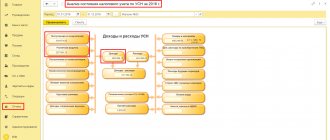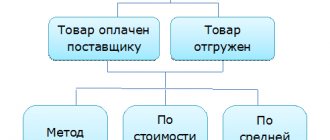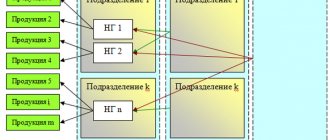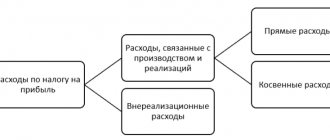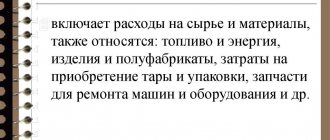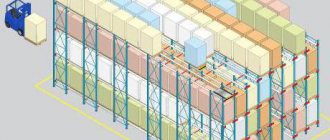Cost is the most important part of calculating the final price of goods, works and services. It is an indicator of operational efficiency and one of the levers for minimizing costs.
Cost price
The monetary expression of the total costs incurred by an enterprise in the process of production activities.
The concept of “cost” reflects different aspects of activity, on which its type and method of calculation depend, as follows:
- Full cost - all costs for the production of products and transportation to the place of sale of goods;
- Marginal cost is the cost of production and transportation per unit of output.
- Production cost – costs associated only with the production of products;
Differences in cost calculation in UT 10.3 and UT 11
UT 10.3 uses classic batch accounting using the FIFO method. At the same time, the system stores information about the cost of each batch of incoming goods. The FIFO method assumes that when a product is disposed of, the quantity and cost of the product must be written off sequentially from the earliest, in terms of time of receipt, batches.
In UT 11, cost calculation is performed using the FIFO method and is based on the accounting provision (PBU) “Accounting for inventories PBU 5/01”. In accordance with this, the balance of goods in the warehouse is calculated in quantitative terms. Next, the valuation of the balance at the end of the month is determined, which corresponds to the calculation of value using the FIFO method. To do this, the quantity and value of the remaining goods are collected sequentially from the last batches, according to the time of receipt, since calculation using the FIFO method implies that the first batches have already been written off. Then the quantity of goods removed from the warehouse during the month is determined. The cost of goods receipts for the month is determined taking into account the value of the initial balance, and from this value the cost of the balance at the end of the month, calculated using the FIFO method, is subtracted. The resulting value indicates the cost of writing off the goods for the month. The cost of writing off a unit of goods is determined as the cost of writing off goods for the month, divided by the quantity of goods disposed of in the month. The cost of each shipment is calculated as the product of the cost of a unit of goods and the quantity of goods written off.
Calculation of prices in trade
Cost calculation in trade enterprises
Cost calculation in industrial enterprises is carried out using four or more standards for calculating overhead costs in the main and additional places where costs arise. When determining the cost of goods, trading enterprises work with only one standard. It covers all transactions that trade in goods entails: rental of premises, storage costs, wages, insurance, interest, write-offs, etc.
A supermarket may have different cost centers depending on its product range. For example, the vegetable department, departments of cosmetics, detergents, alcoholic beverages, shoes, etc. Therefore, trade enterprises may have several such standards for each assortment. They follow from the production accounting sheet, in which the main cost centers are divided by assortment so that for each assortment and for each main cost center, its own rate for calculating overhead costs is obtained.
The production accounting sheet of a trading enterprise can also reflect auxiliary costs that arise due to such intra-company services as, for example, a warehouse, intra-company transport, a canteen, etc. Similar to industrial enterprises, intra-company calculations are carried out in order to causally distribute the costs of auxiliary locations to the corresponding main cost locations.
Rice. 1. Production accounting sheet for a furniture store
The rate of accrual of overhead costs for an assortment of goods is calculated using the formula:
The volume of purchases is used as the basis for calculating the norm. The term “Volume of purchases” has much in common with the concept of “Costs on raw materials and materials”, however, in industrial enterprises raw materials and materials are processed into finished products, but in trade they are not.
The volume of purchases is determined by multiplying the number of goods purchased by the purchase price:
The rate for calculating overhead costs calculated in this way is used in the scheme for calculating the cost of goods to determine the gross price.
The price calculation scheme in trade is as follows:
Rice. 2. Scheme of price calculation in trade
The purchase price is the price of the purchased goods minus all discounts (such as discounts and discounts), but taking into account the costs of supplying goods without VAT (for example, postage and shipping insurance).
A discount is a percentage discount on the cost of goods when the buyer pays for it before the agreed payment date. The discount amount, as a rule, does not exceed ten percent of the price of goods with deferred payment, and the deferred payment period is no more than one month.
A discount is a reduction in the price of a product presented by the seller, for example, to a regular buyer, mainly when purchasing in bulk. The amount of such reduction usually does not exceed ten percent of the net price.
The purchase and sale agreement may provide for a deferred payment for the purchased goods from the moment of its transfer from the seller to the buyer. Before the expiration of the agreed period, the seller does not have a balance sheet claim in the form of receivables, and the buyer does not have accounts payable. In this case, the price of the product with deferred payment is calculated.
The costs of supplying goods are the costs that are incurred when goods are received. These include postal, transport, customs costs, insurance costs, etc.
To obtain the selling price, in each calculation a premium is calculated to achieve the expected profit (rate of return) and cover business risks, which should provide the company with the opportunity to form reserves to compensate for unexpected losses, make investments to replace fixed assets, rationalize and expand the enterprise on a self-financing basis, other needs.
The purchase or sale price without deferred payment is the price of the product with payment on a cash-for-barrel basis.
Example:
A trading company purchases goods at a net purchase price of 200 € with discounts of 20% discount and 3% discount. At what gross selling price should the goods be offered to customers if the price calculation takes into account 14.80 € of costs of supplying goods without VAT, 30% of the rate of attribution of overhead costs, 25% of profit, 5% commissions, as well as a discount to customers in the form of 2% discount and 10% discount?
Solution:
In calculations, it is necessary to pay special attention to the basic values: the supplier's discount and discount are determined as a percentage amount based on a given number and interest rate.
Interest Z, calculated from the initial number N at a given interest rate i
in relation to the initial number, are called percentages “from one hundred”.
To determine the percentage amount Z for a given number N and a given interest rate i
, this number N should be divided by 100 and the result multiplied by the interest rate
i
:
- Determination of the purchase price:
Calculation of discounts from a supplier offering goods to a trading company is carried out in the order of calculating the percentage amount based on a given number and interest rate. The net purchase price is taken as one hundred percent. With a supplier discount (discount) of 20%, the percentage will be:
The supplier discount (discount) is determined in the same way. In this case, the purchase price with deferred payment is taken as one hundred percent:
By successively subtracting the net discount and discount from the purchase price, we obtain the purchase price without deferred payment. At the same time, the purchase price with deferred payment is also taken as one hundred percent as the basis for calculating the percentage - the purchase price without deferred payment:
By adding to the purchase price without deferred payment the costs caused by the delivery of goods, we obtain the purchase price, i.e. the price at which a trading company purchases goods from a supplier for subsequent resale: 155.20 + 14.80 = 170.00 €.
- Calculation of the rate of accrual of overhead costs:
By summing the calculated norm with the purchase price, we obtain the cost of the purchased goods: 170 + 51 = 221 €.
- Calculation of the preliminary sale price:
The calculation is based on the cost price (100%) and an addition for the expected profit and business risk is determined (221 € ? 25% = 55.25 €). The sum of the cost price and the calculated addition gives a preliminary selling price of 276.25 €.
- Calculation of sale price with deferred payment:
Since commissions and discounts are calculated from the price with deferred payment, this price is immediately taken as 100%. If the commission is set at 5% and the seller discount is 2%, this means that the provisional sales price is 93% of the deferred sales price (= 100% - 2% - 5%). Here there is a case when the interest Z is not calculated per hundred
“, but only from
93
.
Accordingly, the calculation changes
.
In order to determine the selling price without deferred payment, you first need to calculate the commission.
The sales price without deferred payment of 291.10 € is obtained by adding the preliminary price and commission (= 276.25 + 14.85). With a seller discount of 2%, this price is 98% of the sale price without deferred payment.
The seller's discount is €5.94. This results in a deferred sale price of €297.04 (= 291.10 + 5.94).
- Calculation of net selling price:
The net selling price is determined in a similar way. First we determine the seller's discount:
By adding the discount to the deferred sale price, we obtain a net sale price of €330.04.
- Calculation of gross selling price:
VAT of 19% is added to the net sales price (= 100%). The sales tax is 62.71 €. (=19% of 330.04 €). The gross selling price is €392.75.
Simplified methods for calculating prices
If any assortment is always calculated with the same trading costs, expected profit and business risk, commissions and discounts, the calculation can be simplified by placing one trade markup in the form of an interest rate on the purchase price of the product. In this way, based on the purchase price, the net or gross selling price is calculated in one step.
To determine the net or gross selling price directly, the purchase price is multiplied by the so-called multiplier. The multiplier is determined by dividing the gross or net selling price by the purchase price:
or by dividing net or gross sales revenue by the volume of purchases:
The trade margin serves to ensure that, with an established interest rate on the net or gross selling price, the purchase price can be immediately obtained. The trade margin also takes into account the trade premium, premiums for expected profit and business risk, commissions, discounts, and discounts. In contrast to the trade markup (progressive costing), the trade markup is a retrograde costing tool. The difference from progressive costing is that retrograde costing is based not on the purchase price, but on the selling price.
Example:
An individual entrepreneur compiled a production accounting sheet at the end of the quarter:
All amounts are given in euros.
a) Calculate overhead costs at major cost centers,
b) Determine the overhead rate for each major cost center,c) Establish for each major cost center a markup percentage to achieve the expected profit if the following net revenues are received:
Frozen food 246.790 €
Fresh food 174.408 €
Canned food 343.845 €.
d) Calculate the trade markup (net) for each major cost center,
e) Determine the trade margin (net) for each major cost center,f) Calculate the net selling price for one unit from the assortment of fresh produce, the purchase price of which cost the entrepreneur 2 €.
Solution:
a) Calculation of overhead costs:
All amounts are given in euros.
b) To determine the rate of accrual of overhead costs for each main cost center (assortment), we use the formula:
c) Step 1: Determine overhead costs:
Frozen food: 116.000 € + 98.600 € = 214.600 €
Fresh food: 68.800 € + 65.360 € = 134.160 €
Canned food: 169.800 € + 135.840 € = 305.640 €
Step 2: Profit calculation:
Frozen food 246.790 € – 214.600 € = 32.190 €
Fresh produce: 174.408 € – 134.160 € = 40.248 €
Canned food: 343.845 € – 305.640 € = 38.205 €
Step 3: Calculation of the percentage markup to obtain the expected profit is carried out according to the formula:
d) Determination of trade markups:
e) Determination of trade margins:
f) Calculation of the net selling price of one unit of fresh produce:
Example:
The accounting department of a commercial enterprise has the following data for May 2013:
The costs of auxiliary places - warehouse and management - should be included in the main places of their occurrence in the following proportions:
Warehouse 5:3:2
8:6:6 control
a) Draw up a production accounting sheet and make a calculation of products used for internal purposes.
Calculate the overhead costs of the main cost centers and the corresponding overhead charge rates! b) Determine the cost for each group of goods.c) Calculate the percentage markup to earn profit for each product group.
d) Perform the calculation for products that the retailer purchased at a purchase price of 5 € and resells with a 2% discount and a 10% discount!
Solution:
a) Production record sheet:
All amounts are indicated in euros.
The rate of accrual of overhead costs for an assortment of goods is calculated using the formula:
b) Cost calculation:
c) Determining the percentage markup to obtain the expected profit:
d) Costing:
Retrograde and differentiated costing
The price calculation discussed so far is a progressive calculation, in which the offer or sale price is determined through the cost price, taking into account the profit margin and discounts provided to customers. Retrograde costing, on the contrary, proceeds backwards from the sales price to production costs and material costs and is used if, for example, a client needs a product manufactured for him, about which he already has accurate price ideas (for example, for competitors' products). Based on a certain level of market prices, retrograde costing determines the costs accepted by the market.
Let's look at retrograde calculation in trading:
Rice. 3. Scheme of retrograde calculation in trade
We will explain the retrograde calculation method in trading using the following example:
Example:
After comparing the prices of competitors, the company decided to sell the product at a net price of 500 €. Determine the net purchase price if the cost of supplying the goods is 2%, the overhead rate is 25%, the profit rate is 22.5% (profit and risk), the buyer's discount is 2%, and the buyer's discount is 5%. The supplier provides a 10% discount and a 2% discount when paying for goods within 14 days.
Solution:
Often the price of a product is set by the market and the company needs to determine, when the cost has arisen, a premium to achieve the expected profit (rate of return) and cover business risks, as well as commissions, discounts and discounts. In this case, differentiated costing is used.
With the help of differential costing, a company can check whether the actual profit coincides with the expected profit. To do this, the cost is first calculated using progressive costing, then the preliminary sales price is calculated using retrograde costing.
In trading enterprises, the cost is calculated from the net or gross selling price using direct (progressive) calculation, and from the net or gross selling price to the preliminary selling price, reverse (retrograde) calculation is used. Profit is determined from the difference between the cost and the preliminary selling price. In this case, the premium for achieving the expected profit (rate of return) and covering business risks is included in the cost price, and not in the preliminary selling price.
Rice. 4. Differentiated costing in trade
Example:
The company offers the product at a net selling price of 401.09 €. Manufacturing the product incurs 120 € of direct material costs and 60 € of direct costs of paying wages to basic workers. The calculation takes into account the following rates for assigning overhead costs to the main cost centers: material 30%, manufacturing 80%, management 15% and 10% in sales. In addition, the company calculates 20% profit, 3% discount and 5% discount.
Is it worth it for a company to manufacture a product under such conditions? Justify your decision.
Solution:
The company should not manufacture this product, because... the rate of return is 12% versus the estimated 20%.
Example:
The importer of fresh vegetables receives 4,000 kg of potatoes at a net price of 2,450 €. The supplier provides a 15% discount and 2% discount. Delivery costs without transport costs are 0.075 € per 10 kg, transport costs are estimated at 452.75 € net. The vegetable importer applies an overhead rate of 25%. Potatoes are resold to retail with a 5% discount, 2% discount and 8% commission. The net selling price is 4,200 €.
a) What profit does the vegetable importer expect to receive?
b) Determine:
- Trade allowance
- Trade margin and
- Animator.
Solution:
a)
b)
Literature:
- Mirja Mumm, Kosten- und Leistungsrechnung, Leipzig 2008, ISBN 978-3-7908-1959-5.
- Gunther Friedl, Christian Hofmann, Burkhard Pedell: Kostenrechnung. Eine entscheidungsorientierte Einfuhrung. Munchen 2010, ISBN 978-3-8006-3595-5.
- Andreas Schmidt, Kostenrechnung: Grundlagen der Vollkosten-, Deckungsbeitrags- und Planungskostenrechnung sowie des Kostenmanagements. Stuttgart 2008, ISBN 978-3-17-020417-1.
- Liane Buchholz, Ralf Gerhards: Internes Rechnungswesen: Kosten- und Leistungsrechnung, Betriebsstatistik und Planungsrechnung. Heidelberg 2009, ISBN 3790823422, 9783790823424.
Author: Michael Berngardt
https://betriebsbuchhalter.de/
Analytics in cost
Calculation of the cost of goods in UT 11 is carried out in the context of the following analytics:
- Organization, warehouse;
- Nomenclature, characteristics of nomenclature;
- A number of other analysts.
Cost accounting by analyst is carried out independently . One product item in different warehouses may have different costs. Cost calculation is carried out based on analytical objects. In this case, each analytics object is formed by the above parameters. For each analytical object, a linear equation is compiled. Thus, a system of linear equations (SLE) is obtained. Linear equations are compiled based on the identity:
Cost of Goods Balances at the End of the Month = Cost of Receipts for the Month + Cost of Initial Balances – Cost of Write-Offs for the Month
Before compiling the SLU, the system calculates the total balance that should remain in the warehouse using the FIFO method. In this case, the valuation of the remainder is determined based on the latest batches.
FIFO method in warehouse program
Despite the fact that the FIFO method is quite simple in terms of understanding the principle of its operation, manually calculating the cost each time is very labor-intensive. Especially if you have a small business, and you yourself are the director, the cashier, the accountant, and the chief buyer. It is much easier if you simply enter data on deliveries and sales and immediately get the result. This is exactly how you can work with the MyWarehouse service. The program fully automates trading processes and itself calculates the cost of written-off goods using the FIFO method. MyWarehouse calculates profitability for each product or product group, stores and displays current and historical balances, as well as many other data that may be useful. This way, you save time and can be confident in the accuracy of the indicators on which you make decisions.
Company accounting policy
According to the law, the organization itself chooses how to calculate the cost of goods. It is important that the method you consider is necessarily reflected in the company's accounting policies. This is stated in Article 313 of the Tax Code of the Russian Federation, as well as in paragraph 73 of the Methodological Instructions approved by Order of the Ministry of Finance of Russia dated October 28, 2001 No. 119n.
Changes to accounting policies can be made once a year. That is, you can deposit them earlier, but they will take effect according to the law next year - at the beginning of the new tax period. The accounting policy is drawn up by an accountant and approved by the head of the organization.
For management accounting purposes, you are free to use any costing method. Our advice is to use the same one that is written down in your accounting policy - this way there will be less confusion.
Features of cost calculation
There are some features in calculating cost using the FIFO method in UT 11:
- The party is clearly absent. This means that it is not possible to obtain a valuation report for the lots. To isolate specific batches, you need to use additional characteristics of the nomenclature, or separate accounting by departments/managers;
- All unwritten batches from the previous month are combined into one batch. The quantity and value of this lot is the sum of the number and value of unwritten off lots;
- All receipts of one product from one supplier within one calendar day are considered one batch. The quantity and cost of this batch consists of the quantity and cost of goods received;
- All write-offs of goods within one month are accounted for at average cost, regardless of the method used to value goods when written off (at average cost, FIFO);
- Movements of goods and other transactions without a known valuation are not used in the valuation of the balance of goods in the warehouse at the end of the month. This rule has an exception. These operations are taken into account in the valuation of the remaining goods in the warehouse, in the event of a shortage of current receipts of goods with a known value.
Pros and cons of the technique
In comparison with classic batch accounting in UT 10.3, cost calculation using the FIFO method in UT 11 has pros and cons.
Pros:
- The system is not sensitive to the order in which receipt and sales documents are entered;
- The time for cost calculation and period closure has been significantly reduced;
- Managers' manipulations with the timing of document processing are eliminated by averaging the cost of written-off goods within all documents of the month.
Minuses:
- Lack of possibility of batch evaluation after implementation of the implementation document;
- The inability to instantly assess gross profit when posting a sales document.
Accounting in retail trade
Accounting in retail can be carried out in two ways: the first method is similar to accounting for goods in wholesale trade, and with the second method of accounting, you need to use account 42 “Trade margin”. Let's consider transactions using account 42.
Receipt (purchase) of goods
Debit 41 Credit 60 - purchased goods from a supplier.
Debit 19 Credit 60 - VAT allocated.
Debit 41 Credit 60 - reflected other costs that increase the cost of purchased goods.
Debit 41 Credit 42 - showed the trade margin.
Selling goods
Debit 50 (62) Credit 90 - showed the proceeds from the sale of goods to the buyer.
Debit 90 Credit 68 - VAT was charged on the sale.
Debit 90 Credit 41 - the book value of goods was written off.
Debit 90 Credit 42 - the trade margin was minus (reversed).
Debit 90 Credit 44 - took into account the costs of selling goods.
Debit 90 Credit 99 - identified the financial result from the sale of goods.
How are warehouse movements taken into account in UT 11?
In UT 11, a warehouse is understood as a certain territory where goods are stored. A warehouse can be presented in the form of racks, shelves and cells designed for storing goods. In this case, the system can keep records of goods in each cell (address warehouse). The directory “Warehouses (warehouse territories)” is hierarchical . For a group of warehouses, you can configure the selection of this group in orders and invoices for receipt (shipment) of goods. If in one receipt (shipment) document it is necessary to take into account operations for several warehouses, then these warehouses must be placed in a warehouse group. If warehouses belong to different groups (not related by hierarchy), then it is impossible to carry out group operations with them.
To reflect the operation of moving inventory items from one warehouse to another, the “Movement of Goods” document is intended, which performs movements in the “Cost of Goods” register in quantitative terms. The valuation is established by the document “Calculation of the cost of goods”. In addition, movements are carried out through the registers Goods of organizations, Goods in warehouses, Free balances.
Accurate costing
Starting with version 3.0.53 in 1C: Accounting 8, it became possible to calculate the cost of production, taking into account the specific costs of manufacturing specific types of products or semi-finished products. For this purpose, account 20.01 “Main production” now has a subaccount Products.
Please note that costs allocated to this subconto are included in the cost of production of a specific item, whenever possible. In particular, if the specified products are not released, then the costs will be included in the cost of other product items belonging to the same product group, as if the subconto had not been filled in.
In the tabular part of the documents Shift Production Report, Receipt from Processing, Request-Invoice, etc., the Products column now appears. This field can be filled in (manually or automatically), or it can be left blank for those materials for which it is unknown or impractical to determine what specific products (semi-finished products) they were spent on.
In this case, the cost of materials is distributed across the product group in proportion to the planned cost, as before.
In simple production conditions, when only one item group is used, the Item group field is not displayed in documents by default. At the same time, the Nomenclature Group subconto does not disappear anywhere, since it remains:
- in the chart of accounts for accounts 20 and 23;
- in postings as Main item group;
- in the directory Nomenclature groups.
If the user creates a second item group, the Item Group field will immediately be displayed in the documents.
If, for the compatibility of calculation indicators, it is necessary to maintain the behavior of the program similar to previous versions, then the Products subconto can be removed from the account 20.01, which will not lead to loss of data in the documents. Also, the Products subconto can be deleted if account 20 is used for additional cost analysis of enterprises providing services, and costing by item groups is sufficient.
On the contrary, if auxiliary production manufactures products or provides services, the cost of which needs to be calculated more accurately, the Products subconto can be added to account 23.
New features of the program allow you to combine costs, both distributed within a product group and directly related to a specific product, when calculating product costs.
Let's use the conditions of Example 1 and consider how the cost will be calculated if for each material we indicate the name of the product for the manufacture of which it was used. Let's reflect the production output and write-off of materials in one document Production report for the shift - the Products (Fig. 1) and Materials (Fig. 2) tabs.
Rice. 1. Write-off of materials in the “Shift Production Report”, “Products” tab
Rice. 2. Write-off of materials in the “Production report for a shift”, tab “Materials”
Other costs of main production accounted for on account 20 (wages and insurance premiums, depreciation of fixed assets, etc.) are included in the cost of a specific product item if it is indicated in the Products subconto. If the Products subconto is not filled in in the relevant documents, then the costs are distributed across the product group in proportion to the planned cost, as was the case before.
After completing the routine operation Closing accounts 20, 23, 25, 26, which is included in the Closing of the month processing, we will generate a certificate-calculation Cost calculation (Fig. 3).
Rice. 3. Accurate costing
The cost calculation form starting from version 3.0.52 “1C: Accounting 8” is a full-fledged report that displays cost data in the following sections:
- period of occurrence of costs;
- expense account;
- cost element;
- cost item;
- material.
In addition, the amounts of work in progress (WIP) at the end of the reporting period are now calculated and displayed in the calculation in detail - in the same sections as data on the cost of products produced or services provided.
Thus, new possibilities for calculating the cost of products (semi-finished products) allow:
- obtain a calculation corresponding to the actual consumption of raw materials;
- get clear data in the Costing report;
- do not abandon the enlarged grouping for the sake of obtaining a calculation;
- avoid creating unnecessary item groups;
- avoid averaging the consumption of raw materials and supplies within product groups;
- organize complex accounting - combine the allocation of costs to both products and product groups.
Preliminary cost calculation
It is recommended to carry out cost calculations multiple times over the course of a month using the “Preliminary” calculation option. To do this, in the client-server version of work, you can configure a routine task. In this case, the calculation is carried out relatively quickly. The cost of each disposal and the cost of remaining goods are not calculated. The document determines the average cost of goods and records it in the information register “Cost of goods”.
It is convenient to analyze the preliminary cost in the “Income and expenses” and “Sales volume by type of goods” reports. To generate reports, go to the “Finance” section and execute the “Finance Reports” command in the navigation panel.
Concluding remarks
Typically, in enterprises, with rare exceptions, documents do not keep up with actual trade transactions and, as a rule, are entered into the accounting system retroactively, corrected, reposted, etc. With a large turnover, restoring the sequence of documents in UT 10.3, calculating costs and closing the period requires significant costs. The advantage of UT 11 in these operations may be a decisive factor in the choice of an accounting system for trade enterprises, especially for those for whom it for management accounting to obtain results that are independent of the order of entering documents for the receipt and sale of goods.
Formula for calculating production costs
Sb(pr) = Pf + Ohm + Sm + E + A + Or + Nr + Co + Tsr
| Pf - costs for semi-finished products Om - purchase of basic materials Cm - related resources Tr - transport costs E - payment for electricity Sat - costs of selling goods A - depreciation of funds | Or - [salary](https://studwork.org/spravochnik/ekonomika/formuly-po-ekonomike/formula-zarabotnoy-platy) to the main personnel Nor - non-production costs Нр - bonuses for workers Co - insurance contributions CR - expenses within the workshops Units – number of units issued during the period |
Example
Find the cost of production of one notebook if, as a result of producing a series of 1200 pieces, the company suffered the following losses in a month:
- raw material costs 72,000 rubles.
- delivery of paper and components 2500 rub.
- electricity payment 3400 rub.
- salary 45,000 rub.
- contributions to the Social Insurance Fund 15,750 rubles.
- other expenses 2950 rub.
Solution
Let's find the amount of production costs (total cost for the month) Sat (total) = 72000 + 2500 + 3400 + 45000 + 15750 + 2950 = 141600 rub.
Let's find the cost per unit of output Sat (unit) = 141600/1200 = 118 rubles.
Example
A motor transport enterprise produces 2,500 units of the first type and 3,600 units of the second type per month. Calculate the production cost for the month if:
- metal costs 560,000 rub.
- costs for lubricants 35,000 rubles.
- wages for shop workers are 120,000 rubles.
- payment to the audit organization 8500 rubles.
- payment of transportation costs to dealer centers 45,000 rubles.
Solution Production costs do not include audit fees and transportation costs! 1. Let’s find the amount of production costs (for the entire output) Sat(pr) = 560,000 + 35,000 + 120,000 = 715,000 rubles.
The cost of production depends on the conditions of production and sale of products, as well as the cost distribution policy. The efficiency of enterprises and their pricing strategy depend on how effectively the cost is predicted.
